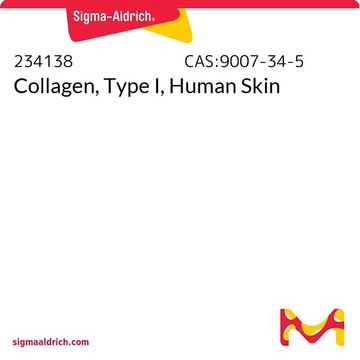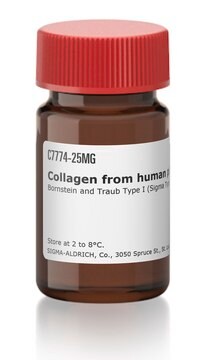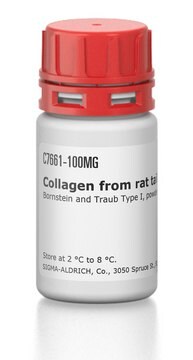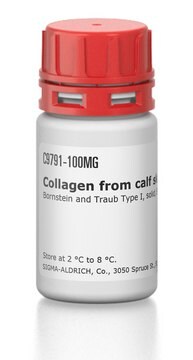추천 제품
product name
Collagen Solution from human fibroblasts, 3 mg/mL, sterile-filtered, BioReagent, suitable for cell culture
생물학적 소스
human fibroblasts
Quality Level
무균
sterile-filtered
제품 라인
BioReagent
형태
solution
포장
pkg of 20 mL
농도
3 mg/mL
기술
cell culture | mammalian: suitable
표면 범위
6‑10 μg/cm2
결합 특이성
Peptide Source: Collagen
Peptide Source: Elastin
외래 활성
endotoxin ≤5.0 μmole/min-mg protein
배송 상태
wet ice
저장 온도
2-8°C
일반 설명
Collagen constitutes to one-third of the total protein in humans. Collagen fibril is the basic component of the tissues containing collagen. It is predominantly expressed in the extracellular matrix.Type I collagen is a major structural component of skin, bone, tendon, and other fibrous connective tissues. It differs from other collagens by its low lysine hydroxylation and low carbohydrate composition. Type I collagen is a heterotrimer composed of two α1(I) chains and one alpha2(I) chain, which spontaneously form a triple helix scaffold at neutral pH and 37 °C. Purified human collagen solution is produced from neo-natal human fibroblasts that have secreted human extracellular matrix (hECM) using a propriety cell culture production system. This product contains a high monomer content. In vitro cultures were prepared using intensively tested human fibroblast cells and purified using a manufacturing process following applicable aspects of cGMP. The human fibroblast cells have undergone significant testing demonstrating safety from viruses and other adventitious agents. This process contains built-in, validated steps to ensure the inactivation of possible prion and/or viral contaminants.
애플리케이션
Collagen Solution from human fibroblasts has been used
- as a component of coating solution for human bone marrow chip fabrication.
- in fibroblast-like synoviocytes culturing.
- as a coating solution for microchannels for organ chip culture
생화학적/생리학적 작용
Collagen is an essential ingredient of connective tissue. Studies in a Chinese family show that mutation in COL1A1 (collagenase type I) is linked with type I osteogenesis imperfecta. Collagen is linked with subchondral turnover of bone, and might have potential as marker to determine the state of joint space narrowing and osteophytes in osteoarthritis.
Proteins belonging to the collagen family supports and nourishes body tissues such as tendons, cartilage, skin and sclera of the eye. Collagen type 1 is a versatile building material required for tissue elasticity and maintains its stability and strength. Collagen is also present in byssus thread of invertebrates, which helps in surface attachment. Defective collagen affects the biomechanical property of arterial tissues.
적합한 제품을 찾을 수 없으신가요?
당사의 제품 선택기 도구.을(를) 시도해 보세요.
Storage Class Code
10 - Combustible liquids
WGK
nwg
Flash Point (°F)
Not applicable
Flash Point (°C)
Not applicable
시험 성적서(COA)
제품의 로트/배치 번호를 입력하여 시험 성적서(COA)을 검색하십시오. 로트 및 배치 번호는 제품 라벨에 있는 ‘로트’ 또는 ‘배치’라는 용어 뒤에서 찾을 수 있습니다.
이미 열람한 고객
Collagen: structure and mechanics, an introduction
Collagen, 1-13 (2008)
Cecilie Kjelgaard-Petersen et al.
Biomarkers : biochemical indicators of exposure, response, and susceptibility to chemicals, 20(8), 547-556 (2016-02-11)
Characterize biomarkers measuring extracellular matrix turnover of inflamed osteoarthritis synovium. Human primary fibroblast-like synoviocytes and synovial membrane explants (SMEs) treated with various cytokines and growth factors were assessed by C1M, C3M, and acMMP3 in the conditioned medium. TNFα significantly increased
Aspek Klinik, Genetik dan Molekuler Osteogensis Imperfekta
Mariska M and Auerkari EI
Journal of Dentistry Indonesia, 14(2), 95-110 (2015)
Frederick Grinnell
Trends in cell biology, 13(5), 264-269 (2003-05-14)
Research on fibroblast biology in three-dimensional collagen matrices offers new opportunities to understand the reciprocal and adaptive interactions that occur between cells and surrounding matrix in a tissue-like environment. Such interactions are integral to the regulation of connective tissue morphogenesis
Synovitis biomarkers: ex vivo characterization of three biomarkers for identification of inflammatory osteoarthritis
Kjelgaard PC, et al.
Biomarkers, 20(8), 547-556 (2015)
문서
Extracellular matrix proteins such as laminin, collagen, and fibronectin can be used as cell attachment substrates in cell culture.
자사의 과학자팀은 생명 과학, 재료 과학, 화학 합성, 크로마토그래피, 분석 및 기타 많은 영역을 포함한 모든 과학 분야에 경험이 있습니다..
고객지원팀으로 연락바랍니다.






